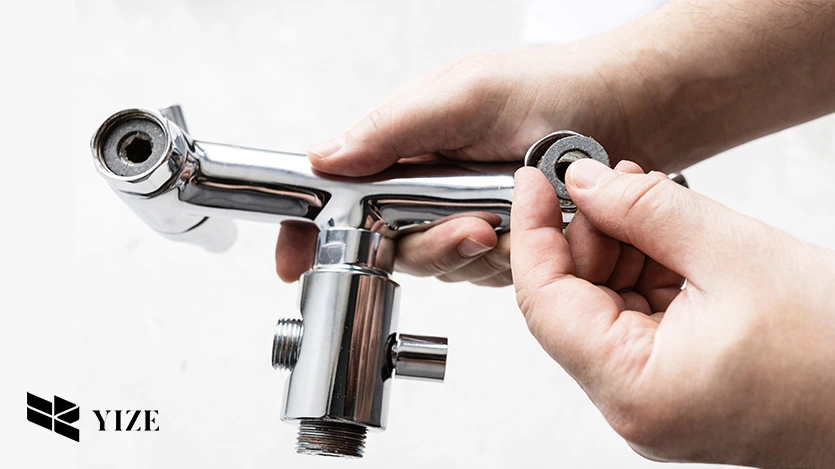
I. Introduction
A leaking shower drain is a simple problem that, if not fixed, can lead to a massive problem in the future. The poop or leak in your shower drain might appear insignificant. However, it is one of the leading causes of water damage that results in costly repairs and even structural deterioration of your home. Water stains and leaks require prompt attention, or else they lead to mold, mildew, and wood rot formation.
This should be done quickly to prevent damages to the bathroom and the remaining sections of the home from occurring. This article should help people understand the factors that lead to shower drain leaks, the first indications of the problem, and how it can be solved before it worsens and requires extensive repairs.
II. Part 1: Understanding Shower Drain Leaks
1. Common Signs of Shower Drain Leaks
Bathtub leaks can be quite difficult to diagnose at times because the water may be accumulating behind floors or walls. However, some common signs indicate a possible leak:
●Dampness on the ceiling or wall near the bathroom
●Foul smell caused by the buildup of mold or mildew
●Loose or discolored floor tiles
●Peeling paint or wallpaper
●Presence of mold and mildew around the shower area or wet areas of the lavatory
2. What Causes Shower Drain Leaks?
These are some of the causes of shower drain leakage: Such problems may be attributed to improper installation, degradation with time, or damage to certain parts. This means that even if it is just a small issue, it shall grow into a bigger problem if not solved.
3. How to Be Sure if Your Shower Drain Leaks?
For you to be sure that your shower drain is indeed leaking, you need to examine the area around the shower drain and perform other tests which are explained below. It will also help to act immediately when you notice signs of a leak in order to reduce the extent of the damage.
III. Part 2: Common Causes of Shower Drain Leaks

1. Poor Installation or Faulty Components
Another reason for shower drain leakage is the installation one, namely, the absence of correct mounting of the shower drain. Basically, it means that if the assembled components of the drain are not well oriented to the expected plane or well fixed to the ground, then the water can permeate the surrounding space. Faulty or inferior material during installation also lead to leakage since water seepages through the weak areas.
2. Cracked or Broken Drain Pipes
These pipes are liable to crack or break if they have aged or if there was an accident and is definitely connected to the shower drain. When this occurs, water may freely flow out before it gets to the principal sewage system and cause leakage behind the shower or walls.
3. Worn Out Seals and Gaskets
Seals as well as gaskets help to avoid water leakage in the drain system. These parts degenerate due to general use and exposure to moisture which is a common phenomenon in vehicle operations. As seals degrade, they are unable to stop water from infiltrating through the drain, causing damage.
4. Misaligned Drain Components
That is, if the components for a drain are not well placed or if there are distortions over time, then there will be small openings through which water can easily find its way out. This misalignment is usually as a result of shift of shower structure or poor installation of shower head.
5. Accumulated Debris Blocking Proper Drainage
Soap, hair, dust and other solid particles may form a layer at the bottom of the drain and thus obstruct the flow of water. This not only delays the process of drainage but also exerts pressure on seals as well as pipes which results in leakage. Backflow also prevents water from flowing through the pipes as expected, which can lead to water accumulating around the drain area and thus cause more leakage.
IV. Part 3: How to Determine Where a Shower is Leaking?
1. Visual Inspection
The first step in identifying a leak is a thorough visual inspection.
●Checking for Visible Water Damage: Be on the lookout for water stains, peeling paint, and walls and floors that are warped on and especially around the shower area.
●Identifying Mold and Mildew Build-Up: The Mould and mildew in most cases form when there is an excess of this fluid. If you find these near the drain, then it might be a sign that you have a leak.
●Inspecting Grout Lines and Seals: Inspection for stains, textured surface, grout between tiles, or condition of seals around the shower. If there are small openings in these areas, you would observe that water could leak through.
2. Water Test
A water test can be done that would define whether the drain is leaking or not. Here is the step-by-step guide:
●A few strategies include: Place a stopper on the drain or use tape to block the opening.
●Ensure that there is a small amount of water in the shower base.
●One hour later, one should check if the water seeped to the floors downstairs from the one the water was left to stand in.
●Isolating the Shower Area: To make sure the leak is not coming from the walls or somewhere else, do not spray water on tiles or walls while carrying out the test.
●Tools and Materials Needed: Drain stopper and measuring cup to manage any spillage as well as towels to wipe the excess.
3. Using Food Coloring
From this argument, it can be suggested that food coloring can be useful in the identification of the source of the leak.
●How it Works: Before doing the water test, pour a few drops of food color into the water. When you detect coloured water seeping out of the drain or even on the floor beneath the drain, you are likely to be dealing with a drainage leak.
●Interpreting Results: If the colored water appears in the wrong places, then you have located the bad zone.
4. Inspecting Plumbing Connections
In other cases, the leak’s source comes from plumbing joints and connections that have developed issues.
●Accessing the Plumbing: This will demand retrofitting work, meaning that you may need to dismantle part of your ceiling or cut through your walls to access the pipes underneath the shower.
●Tips for Identifying Loose or Damaged Connections: Check for sliding parts, droplets of water, or any signs of rust on the pipes.
V. Part 4: How to Fix Common Shower Drain Leaks

1. Replacing Seals and Gaskets
Seals and gaskets that have been worn out can be replaced to avoid leakage.
1)Step-by-Step Guide
●Remove the drain cover.
●Remove the old gasket or seal if necessary.
●Clean the drain area.
●Replace the gasket or seal with a new one.
●Make sure they lock the drain cover back into position.
2)Recommended Tools and Materials:
Screwdriver, plumber’s putty, new gasket in the sealer.
2. Tightening or Realigning Components
If misalignment is the problem, the contractors should be able to remedy the situation by either tightening or readjusting the parts to eliminate leakage.
●How to Realign Parts: Remove all the parts of the drain, make sure that all of them are securely connected and then fixed together again.
●Ensuring All Components Are Secure: Ensure that all fittings have been properly fastened so that there is no leakage in the future.
3. Repairing or Replacing Drain Pipes
At other times, the pipes themselves require attention and various types of maintenance.
●Identifying the Need for Pipe Repair: If the pipes are cracked or corroded, it is high time you consider replacing the pipes.
●Techniques for Repair: Fine-line cracks can usually be repaired, while big holes could require the replacement of the pipe in question.
VI. Part 5: Preventative Measures to Avoid Future Leak Issues
1. Regular Maintenance Tips for Shower Drains
●It is also necessary to clean the drain to avoid any blockage from occurring.
●Continually check seals and gaskets for signs of wear and tear at least once every few months.
●It is necessary to look for signs of leaks around the drain area.
2. Best Practices for Installation
Preventing leaks can be easy if there is a proper installation of the pipes from the initial stage. Rely on a professional or strictly obey the handbook’s guidelines.
3. Use of Quality Components like ZATARAIN’s Products for Longevity
Quality materials such as the ones provided by YZDRAIN are vital in eradicating any leaks on the vehicle. YZDRAIN products, in general, are wear-and-tear-resistant, and thus it is less common to need repair services for them.
VII. Part 6: Where is the Best Shower Drain Supplier?
1. Top 5 Shower Drain Manufacturers and Suppliers
●YZDRAIN
●Oatey
●Sioux Chief
●Kohler
●Zurn
2. Why Choose YZDRAIN?
●High-Quality Standards: It should be noted that all YZDRAIN products are manufactured in accordance with strict quality control.
●Durability: They are made to have long service, thus reducing cases of leakage.
●Customer Feedback: YZDRAIN’s products are often commended by customers for their impressive quality and durability.
VIII. Conclusion
A leaking shower drain can be a nightmare but knowing the usual causes of the leak and how to deal with it can go a long way in preventing more damage. This means that once in a while, you have to get in there and check what needs to be fixed or replaced to ensure your bathroom is well maintained. Furthermore, the use of quality hardware like YZDRAIN would guarantee a shower free of any leakage in the next few years.
FAQs
1. Why does a shower drain have a leak?
Some of the causes of the problem include worn seals, misaligned parts, and cracked pipes.
2. Is it possible that my shower drain is leaking?
Search for swelling, discoloring, parts with stains, dampness, and do the water test.
3. Is it possible for me to repair a leaking shower drain on my own?
Yes, it is possible to fix many small leaks using simple tools and accessories that are available in the market. But the large issues may call for a professional.
